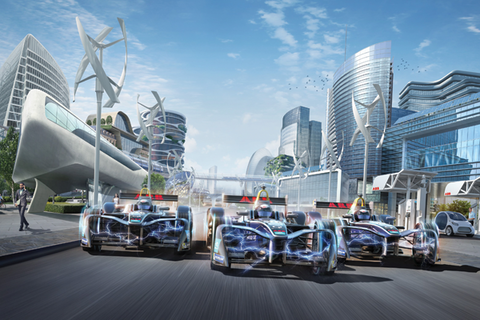As the fourth season of Formula E revs its remarkably quiet engines, Voltimum's Daniel Tovey considers how this burgeoning series is capturing a brand new breed of motorsport fan and pushing the boundaries of electric vehicle innovation.

For Formula 1 fans, the deafening roar of 20 multimillion-dollar cars tearing off the grid is one of the defining spectacles of the sport. Replace the iconic growl of the Formula 1 internal combustion engine with the whistled hum of an electric motor and you get Formula E, the new kid on the motorsport block.
Conceived in 2012, with the first season held in 2014, the ABB FIA Formula E Championship is the world’s first international, fully electric, single-seater category in motorsport. Now in its fourth season, the 2018 championship features ten teams with two drivers each, racing in 11 cities around the globe against the backdrop of iconic skylines such as Berlin, Hong Kong, Paris and New York.
An introduction to the Formula E Championship
The Formula E Championship is similar in structure to its more established cousin. Each event consists of two practice sessions in the morning followed by an hour-long qualifying session. For qualifying, the drivers are split into four groups of five and each group gets six minutes to set their best lap. Drivers can use full power throughout (200 kW) but can only use one of their two cars. The five fastest drivers then take part in a Super Pole shoot-out to determine the top five grid positions.
The actual race lasts for approximately 50 minutes and drivers have a power restriction of 180Kw. Drivers make one mandatory pit stop to change cars. Unless they are damaged, tire changes are not permitted during this pit stop.
Points are awarded, using the standard FIA system, to the top 10 drivers. There are also additional points issued for securing pole position and for achieving the fastest lap time.
The driver with the most points at the end of the season is crowned champion. Likewise, the winner of the team championship is worked out by tallying the total points won by each team’s drivers.
In a bid to make the sport more interactive with its growing fan base, Formula E has introduced FanBoost. This is an online voting system which allows fans to actively influence the outcome of each event. The three drivers who receive the most votes will receive a five-second power boost which can be used twice in a race (once in each car).
A level playing field
In the past, you could forgive motorsport fans for dismissing Formula E as Formula 1’s, gimmicky, politically correct cousin. Whilst it is true that this flourishing series currently lacks the die-hard global audience and commercial muscle of its older cousin, Formula E’s profile is growing with a new generation of motorsport enthusiasts. Targeting those interested in sustainable technological innovation and fan interaction.
It is also appealing to F1 fans who are tired of the disparity in financial clout separating the dominant teams from the rest of the pack. The technical standardisation that has been regulated into Formula E has maintained a competitive, level playing field. It has also forced the teams to squeeze what they can from the technology available.
Eco-friendly entertainment
The faster lap times observed as seasons go by are a welcome indication of the growing spectacle of the sport. However, true innovation in this arena isn’t defined by speed and power, but by efficiency and making electric vehicle technology work harder.
Spectators will see this innovation in action next season when Spark Racing Technology’s new chassis design (the SRT05e) is introduced, which will be lighter and offer more efficient aerodynamics. This will be complemented by a brand-new battery from McLaren, which will offer 54Kw/h and allow drivers to complete a race using just one car for the first time.
This commitment to promoting the benefits of EVs is also reflected by the FIA partnering with ABB, one of the leading manufacturers of electric vehicle infrastructure, as the main sponsor of the Championship. A partnership which Alejandro Agag, founder and CEO of Formula E, labels as an opportunity to, ‘showcase breakthrough technology on a global scale to fans and consumers’.
As the advances nurtured by this sport inevitably filter down from the high spec race cars to the vehicles we see on our roads, today's fans will become tomorrow’s consumers. Formula E’s marriage of spectacle and sustainable innovation is demonstrating the capabilities of electric vehicles on the world stage, challenging our reliance on the internal combustion engine one race at a time.